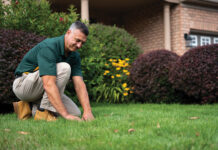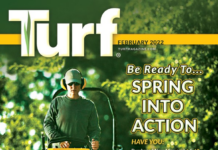Controlling turfgrass diseases is a complex issue. Patience, expense, weather and knowledge are all components of the control matrix. Each one of these can influence the effectiveness of the task at hand — to prevent or reduce damage caused by diseases to the turfgrass that you maintain.
Patience? As humans we realize that we want our goals to be fully achieved right away. Even so, patience is in managing diseases as, sometimes, even our best efforts may not produce the desired results for several weeks.

Expense, of course, is directly related to your company’s bottom line. Yes, if money were no object you could solve your clients’ turfgrass disease damage problems by sodding the property and modifying the soil. However, in order to make sufficient money to stay in business, that’s simply not possible.
Weather is certainly a factor over which you, as property managers and lawn care operators, have little control, but is a major contributor to the outcome of their efforts to maintain turf. You are not able to manipulate natural rainfall, temperature, dew, frost and cloud cover.
But you can control the amount of knowledge you bring to the task of preventing and managing diseases on your clients’ properties. And knowledge is one that is the most likely to provide you the greatest degree of control in a relatively short period of time. As a turfgrass manager, in fact, you’re expected to know the conditions that favor the development of turfgrass diseases, how they affect lawns and how the severity and damage they cause can be controlled.

Best management practices
The best way to prevent turf disease is by implementing best management practices. Proper mowing height, soil cultivation, moderate levels of added nutrients, irrigation to keep roots moist (not soggy or dry), maintenance of tools, calibration of equipment, use of disease resistant turf cultivars, placement in full sun, separation of turf and ornamentals, soil testing and good timing are important issues to consider in overall disease management.

Unfortunately, service providers rarely have complete control over a property. Lawn care operators are often limited by the nature of the contract, in that the homeowner (or another contractor) does the mowing and irrigation. These two basic procedures can either make or break the health of a lawn if completed properly, inconsistently or improperly. Other beneficial cultural practices include aeration, weed control, fertilization, thatch management and insect control.
Property managers are usually in better shape as they care responsible for (and therefore have a good degree of control over) most influences of turf performance. Naturally, with greater levels of responsibility and control come greater expectations from clients. To the degree possible, customers are better served when the best management practices listed above are incorporated into the contract for services.

Proper diagnosis crucial
Property managers and lawn care operators that are new to the green industry often misunderstand that at least half of turfgrass maladies are not caused by fungal diseases, but are due to other causes — weather, vandalism, homeowner oversight or not implementing best management practices. Damage or poor turf performance may, in fact, be the result of poor drainage, thick thatch layer or turf growing in heavy shade. In many cases, several causal agents are responsible. That’s why a turfgrass manager must be inquisitive and detail oriented.
Accurate disease diagnosis
Accurate identification of the pathogen responsible for the symptoms before pest control agents are applied is very important. When an incorrect diagnosis is made, products chosen for what was thought to be the target pest will often not control the problem. Utilizing pest identification resources will greatly reduce misidentification. The following books are good ones to consider as resources as well as the many identification tools offered by land grant universities:
- “Compendium of Turfgrass Diseases”, by Smiley, Dernoeden and Clark
- “Managing Turfgrass Pests”, by Watschke, Shetlar and Dernoeden
- “Integrated Turfgrass Management for the Northern Great Plains”, by Baxendale and Gaussoin
- “Controlling Turfgrass Pests”, by Shurtleff, Fermanian and Randell

Root vs. foliar diseases
When considering turf diseases, think roots and shoots. There are root diseases and shoot diseases and a few that are both root and shoot diseases. Knowing the symptoms of each goes a long way towards narrowing down the number of possibilities. At a bare minimum, making observations about which parts of the plant seem to be affected the most – odd-looking spots on the leaves, mushy roots, interesting patterns on the field – will provide essential information as observations are matched to disease field guides.
Prevention vs. curative
Much like pushing a large rock around, it’s much easier to push it down a slope than up a slope. Whenever possible, implement disease control regimes that prevent turf disease rather than cure them.

Prevention is an ongoing, multi-case control measure, whereas curative measures are a one-time effort and expense. For many lawns, implementing good preventative controls will serve to create positive outcomes on the disease at hand, as well as several other diseases during the remainder of the growing season.
A very important prevention strategy is the utilization of disease resistant cultivars. Certain turf cultivars are inherently more prone to succumbing to a pathogenic disease such as leaf spot/melting out than others, due to their genetic makeup. A good source of data on which cultivars have expressed disease resistance in the past is the National Turfgrass Evaluation Program. NTEP provides ratings of many commercially available cultivars on a regional basis.
Generally more important for root diseases than ones that mainly affect the shoots, adequate soil percolation is important in disease prevention. Through various methods of soil modification and aeration, soil drainage can be improved to permit excessive water to move out of the soil profile, yet allowing sufficient moisture to remain to provide for the needs of the turf. Turf roots that are continually wet often become infected with pathogens such as summer patch and pythium root dysfunction.
Aerating is rarely an “overdone” preventative step. Generally, it’s helpful to aerate turf frequently to achieve uniform/adequate infiltration and prevent drought related combination causes, especially on slopes where water tends to collect at the bottom of the slope after rainfall or irrigation events, creating conditions favorable to root diseases and inadequate moisture retention at the top of the slope.

Controlling thatch is an important cultural practice from a disease control standpoint. For example, there may be classic summer patch or necrotic ring spot symptoms present, but some “on your hands and knees” investigation reveals that an inch of thatch is also present. When this thickness of thatch is present, the turf is very likely to be damaged from a majority of the roots growing in the thatch instead of the soil, inducing moisture and nutrient stress, allowing it to be more susceptible to injury from the disease organisms.
Timing
Timing is everything when it comes to disease control. It is important for management practices as well as curative fungicide applications. For example, the common practice of core cultivation mentioned earlier should be done when the turf is best able to recover from the minor amount of damage that it inflicts. If done in mid-summer to cool-season turf, roots could dry out, causing short-term damage. This is certainly the case for thatch removal, another form of soil cultivation. Timing is just as important for product applications to prevent fungal disease on turf varieties with a history of infection or curative applications made at the onset of symptoms. If preventative applications are made four weeks after symptoms are present, very little actual disease control will be realized.











![[VIDEO] Dickies®: Discover Workwear That’s Anything But Uniform](https://turfmagazine.com/wp-content/uploads/2023/06/1647663814-4b1a2a7742790a9b1e97a3b963477850192e1d6a9dfba9b07214a77bae25d6e3-d-218x150.jpg)





























![[VIDEO] Dickies®: Discover Workwear That’s Anything But Uniform](https://turfmagazine.com/wp-content/uploads/2023/06/1647663814-4b1a2a7742790a9b1e97a3b963477850192e1d6a9dfba9b07214a77bae25d6e3-d-324x160.jpg)